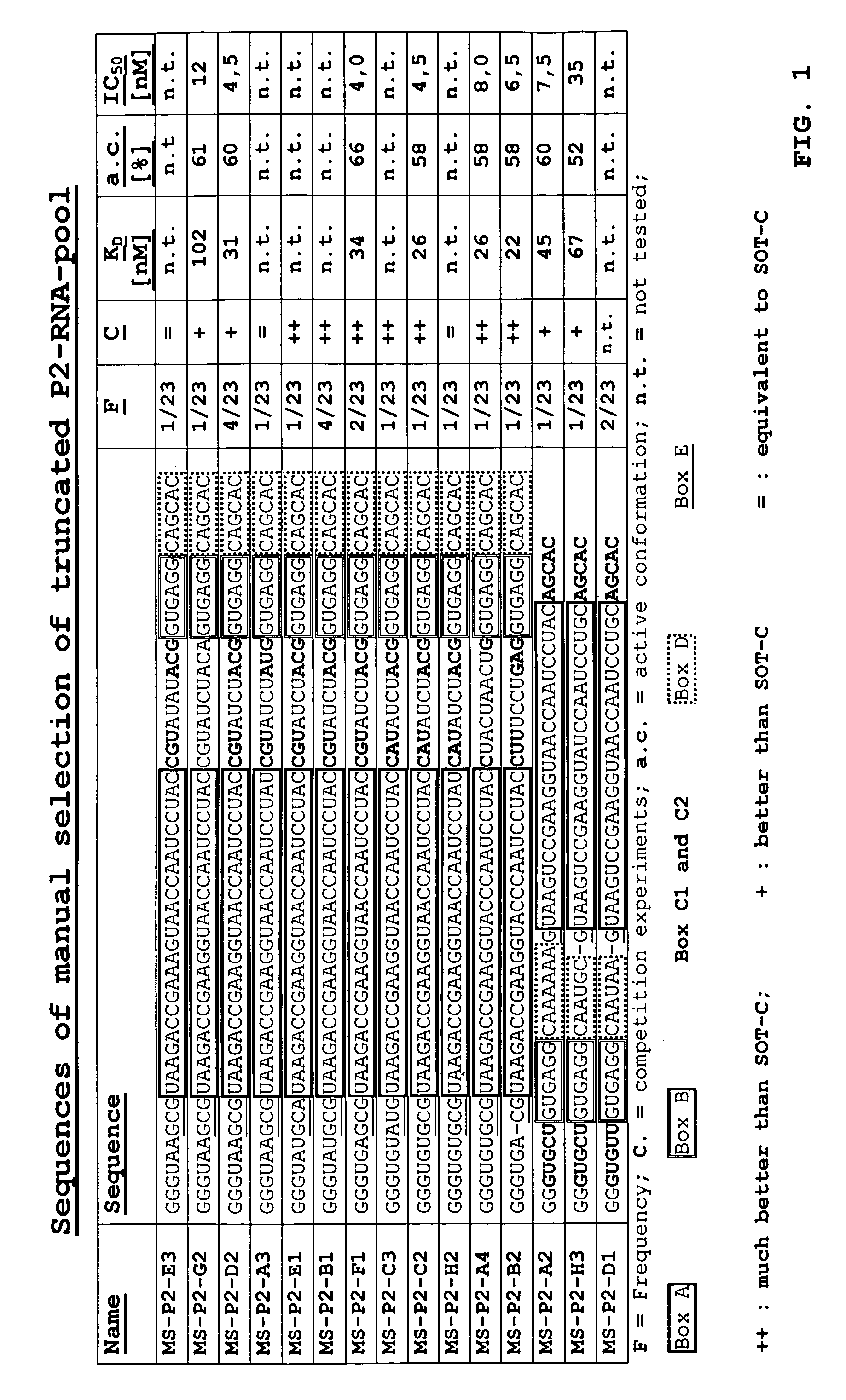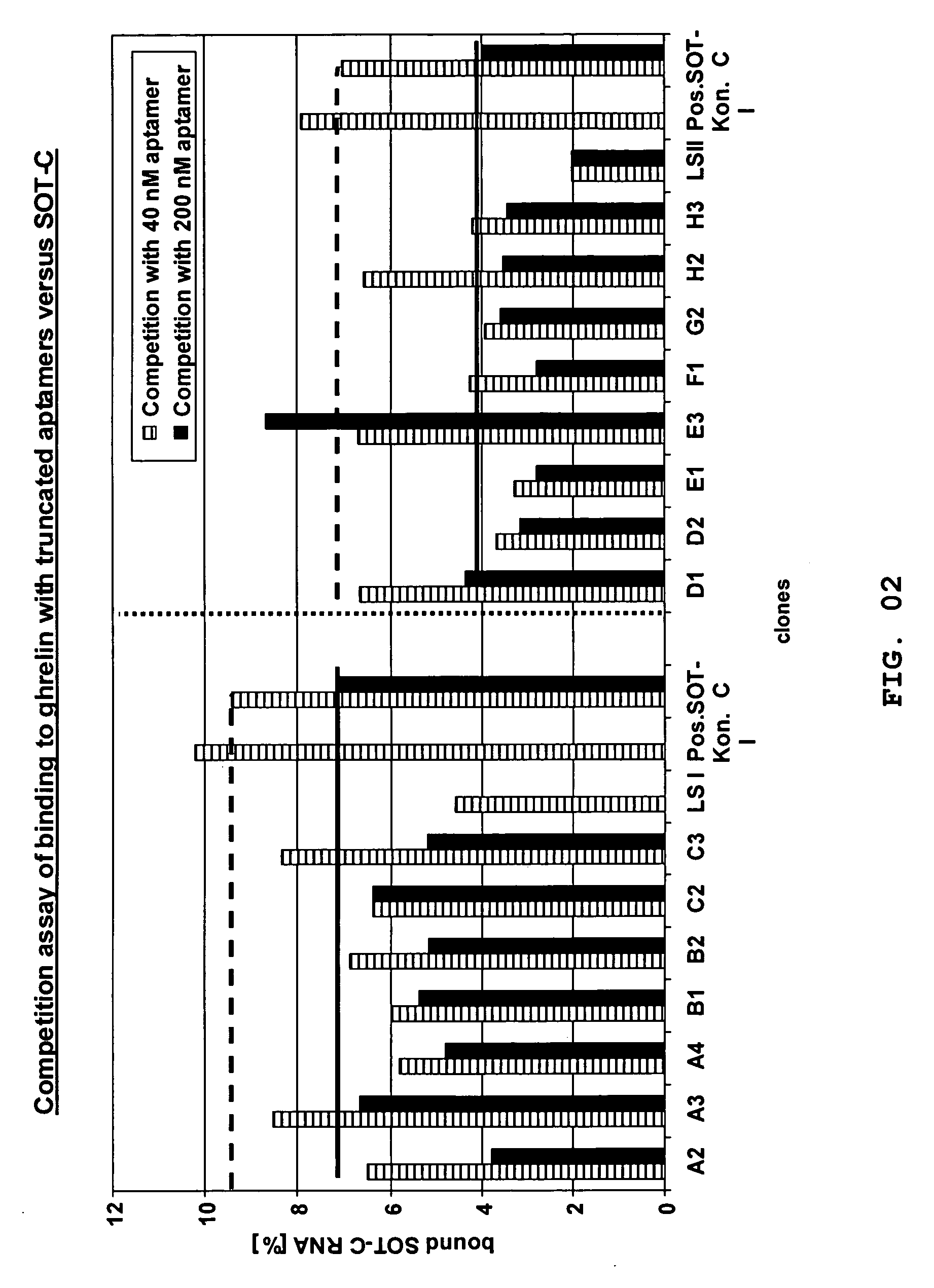Ghrelin binding nucleic acids
a nucleic acid and ghrelin technology, applied in the field of nucleic acids binding to ghrelin, can solve the problems of inducing overeating and hunger in test subjects
- Summary
- Abstract
- Description
- Claims
- Application Information
AI Technical Summary
Benefits of technology
Problems solved by technology
Method used
Image
Examples
example 1
Ghrelin Binding Sequences
[0220] If not explicitly indicated to the contrary, the ghrelin used throughout these examples was ghrelin in its octanoylated form.
[0221] Using a technology derived from the one described in DE 10349441.3 an RNA in vitro selection directed to biotinylated human D-ghrelin was carried out. An enriched population of dsDNA molecules was cloned and sequenced. The result of the sequence analysis can be seen in FIG. 1.
[0222] All sequences comprise the Ghrelin-binding motif A (25 nucleotides) of the known Ghrelin-binding sequence SOT-C (B11trc; see patent application WO2004 / 013274 A2). Only in four out of these 23 clones motiv A is rather located at the 3′-end of the sequence. Within 19 sequences motif A is located at the 5′-end of the clones. Additionally motif called motiv D is located at the 3′-end of motif A.
[0223] Binding Characteristics of the Sequences
[0224] The 15 clones (FIG. 1) showing variations at different positions were chosen for ranking experim...
example 2
Binding Characterization of the Sequences
[0226] 2.1 Ranking of Radiolabeled Aptamers by Using the “Equilibrium Binding Assay”
[0227] Most of the clones that are disclosed herein and that are more particularly listed in FIG. 1 were ranked as radiolabeled aptamers (D-RNA) in respect of their binding behaviour towards biotinylated human D-ghrelin by using the “equilibrium binding assay”.
[0228] A ranking of the binding behaviour of the molecules towards human D-ghrelin was done. For this purpose, using standard protocols as described herein the identified aptamers were synthesized as truncated aptamers (without primer binding sites) as depicted in FIG. 1.
[0229] In the following the aptamer sequences were radiolabeled at the 5′-end with γ-P32-ATP using the following protocol.
Component[final]Oligonucleotide5 μMT4 Forward Reaction Buffer1x(Invitrogen)T4 Polynucleotide Kinase10 U / 10 μlreaction volume(Invitrogen)[γ-32P]-ATP1 μl / 10 μlreaction volume
[0230] The reaction was incubated for 1 ...
example 3
Definition of Ghrelin Binding Spiegelmer Motifs
[0244] 3.1 Truncation of SOT-D-000
[0245] 3.1.2 Terminal Truncation of Previously Selected Spiegelmer SOT-D-000
[0246] The ghrelin-binding Spiegelmers which are shown in FIG. 3 have been obtained previously, as already presented in patent application WO2004 / 013274 A2. In secondary structure predictions (minimum free energy conformations [Hofacker et al., 1994, Monatsh. Chem 125:167-188]), the possibility for canonical intramolecular base pairing between the 5′- and the 3′-terminus becomes obvious for all Spiegelmers (FIGS. 4-7; underlined bases in FIG. 3). The presence of such structural elements in a Spiegelmer may be vital for correct folding of the active three-dimensional structure, but for economical Spiegelmer synthesis, the molecules should be as short as possible. Spiegelmer SOT-D-000 (alias a truncated version of SOT-R04-DR14-F7 without primer binding sites) was chosen as basis for terminal truncation as it is the shortest sel...
PUM
| Property | Measurement | Unit |
|---|---|---|
| molecular weight | aaaaa | aaaaa |
| molecular weight | aaaaa | aaaaa |
| molecular weight | aaaaa | aaaaa |
Abstract
Description
Claims
Application Information
 Login to View More
Login to View More - R&D
- Intellectual Property
- Life Sciences
- Materials
- Tech Scout
- Unparalleled Data Quality
- Higher Quality Content
- 60% Fewer Hallucinations
Browse by: Latest US Patents, China's latest patents, Technical Efficacy Thesaurus, Application Domain, Technology Topic, Popular Technical Reports.
© 2025 PatSnap. All rights reserved.Legal|Privacy policy|Modern Slavery Act Transparency Statement|Sitemap|About US| Contact US: help@patsnap.com



